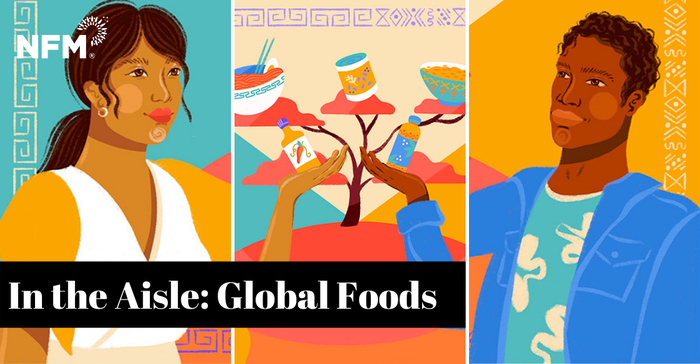
Atlanta-based Nina Tickaradze founded this brand as a social venture to create job opportunities for refugees from her native Georgia—a country where vitamin C–rich rosehip juice is traditionally known to promote health. The organic rosehips in this clean-label beverage, sweetened with a touch of stevia, grow sustainably in the Caucasus Mountains. SRP: $2.99
Sofrito (vegetables, herbs and spices cooked in extra-virgin olive oil) forms the base of this brand's entire selection of savory vegan beans. Each clean-ingredient recipe is based on the flavors of the founders' childhood and inspired by traditional Latin American dishes. This one blends a Puerto Rican sofrito made from tomato, onion, bell pepper and EVOO with pigeon peas (gandules), herbs and rice. SRP: $2.99
Founder Regina Trillo missed her near-daily dose of nopales (prickly pear cactus) from her native Mexico and sought to create a nutrient-dense crunchy snack based on this favorite culinary ingredient. The result is a line of four (three savory and one sweet: churro!) cactus snacks made with amaranth, pea protein, cactus powder, chia seeds and flaxseeds, along with other carefully sourced whole-food ingredients. SRP: $3.99
Tarun and Anu Bhalla draw product inspiration from Anu's childhood spent in the kitchens of her grandfather's legendary restaurant, Moti Mahal in Delhi, India. Today, they hope their richly spiced and flavorful sauces—including this newest iteration—will captivate home chefs with their clean ingredients and wonderfully enveloping aromas. SRP: $7.99
Passionate about the flavors of his Filipino heritage, founder Jake Deleon created a line of gluten-free, vegan Filipino simmer sauces as a hearty, authentic and delicious meal solution for hungry global flavor seekers. Just add a favorite protein to this savory blend of tamari, coconut vinegar, garlic and spices, one of three products in the line. SRP: $6.99
Numa represents three generations of women. Founded by Joyce Zhu with the help of her mother, Jane Xie, this brand adapted its healthy Asian-inspired candies from the ones Xie's mother used to make in China. This new line of mini peanut butter bars has three varieties of plant-based, gluten-free, clean-ingredient crispy sweets, including this tasty Black Sesame Bar. SRP: $3.99
Essie Bartels first got the cooking bug in her mother's kitchen in Ghana, but global travels and influences inspire the flavors of her sauces and dry rubs. This one is both sweet and tangy, made with a blend of tamarind, guava, ginger and vanilla and preserved with lemon and lime. SRP: $10
'Yemisi Awosan's tasty, aromatic grab-and-go soups and sauces are rooted in her Nigerian heritage and inspired by favorite family recipes. The slow-cooked refrigerated soups incorporate carefully sourced ingredients from farmers in West Africa and the New York area. This rich free-range chicken broth is a wellness-supporting mélange of citrusy lemongrass, pepper soup spice (a blend made with calabash nutmeg and grainsof selim) and fiery and floral chili peppers. SRP: $8.99
Demand for bissap has been growing, with each brand putting its own twist on the classic West African hibiscus tea. For this variety—one of four in the line—founder Akua Nettey marries spices and hibiscus flowers from her parents' native Ghana with strawberries sourced from a nearby farm in New York's Hudson Valley, along with blueberries, raspberries and a touch of cane sugar. SRP: $5.19
Food was integral to the upbringing of sisters Vanessa and Kim Pham, daughters of Vietnamese refugees, and their recently launched meal-starter brand feels like a bold and unapologetic homage to all things delicious (and cool). Each meal kit (just add protein) is a chef-curated take on an authentic East Asian or Southeast Asian dish, as well as a celebration of top-notch ingredients, mouthwatering aromas and a palate-popping party. This new sampler is the perfect way to try Japanese Yuzu Misoyaki, Korean Spicy Bulgogi and Chinese Mala Salad. SRP: $29/6-pack
Damaris and Mel Hall began serving up the rich flavors of Damaris's native Kenya at farmers markets, food festivals and a restaurant in Vermont. As parents to a child with severe food allergies, they created this brand of allergy-friendly African-inspired frozen dishes to provide families like theirs with healthy and flavorful meal options. We especially love this "no-nut" vegan stew with yams, carrots, turnips, sunflower seed butter, ginger and spices. SRP: $5.69
Chef Jing Gao's sauces are rooted in the traditions of her birth city of Chengdu, China. Though anchored in tradition, Gao's recipes are very personal, crafted using the highest quality ingredients and drawing from her experiences as a chef in Shanghai and other world-class cities. This one is hot, spicy, crispy and savory, its intense flavors a blend of ultraclean ingredients and bold spices. SRP: $15
Founders Kevin Lee and Kevin Chanthasiriphan nourished their love of noodles while growing up in Taiwan and Thailand. Their three plant-based, instant ramens reflect this love, reimagined to fit healthy modern lifestyles and diets. Made from pumpkinseed and faba bean protein, this plant-based ramen is high protein, low carb and full of complex umami flavors. SRP: $41.99/6-pack
Rosa Li's functional, USDA Organic beverage brand was inspired by the herbal tonics her Chinese grandmother would prepare for her. She re-created their immunity-boosting power in this line of gut-friendly bubbly drinks infused with both pro- and prebiotics and featuring enticing flavor varieties. This one blends rose petals, guava puree, lemon and elderberry juice. SRP: $3.99
Hector Saldivar turned to sustainably grown nopales (prickly pear cactus) to create these grain-free tortillas, blending this ingredient with upcycled okara (soybean pulp) flour (sourced in partnership with Renewal Mill), cassava, avocado oil, lime juice and inspiration from his mother's kitchen in Monterrey, Mexico. The result? These ultraclean, soft and flavorful tortillas. SRP: $7.99
Portland-based Affouet Price inherited her family's passion for the cuisine of her native Ivory Coast, eventually launching this brand of bissap-inspired beverages and mixers at local farmers markets with the help of her mother. This flavor, one of four, blends hibiscus flowers with rose water, orange water and vanilla bean, sweetened with monk fruit and erythritol. SRP: $5
Portland-based Affouet Price inherited her family's passion for the cuisine of her native Ivory Coast, eventually launching this brand of bissap-inspired beverages and mixers at local farmers markets with the help of her mother. This flavor, one of four, blends hibiscus flowers with rose water, orange water and vanilla bean, sweetened with monk fruit and erythritol. SRP: $5
For years, celebrated chef and Momofuku restaurateur David Chang has called for the demise of the grocery store "ethnic" food aisle. In a July 2019 episode of his podcast, Chang slammed this concept as not representative of the multicultural and diverse world we live in or "how we eat in this world today," as he highlighted the antiquated, if not potentially racist, nature of the section.
He makes a good point.
Eliminating otherness
Once upon a time, the international aisle seemed like a practical way to introduce consumers to unfamiliar foods and ingredients. But as the U.S. population has become more demographically and culturally diverse, products that once seemed "foreign" to American palates have long since assimilated into their multicultural diets and culinary lexicon. Yet ethnic or international food aisles continue to highlight the otherness of foods from some, but not all, countries or regions of the world. French cuisine, for example, has never been defined as ethnic, noted Krishnendu Ray, associate professor of food studies at New York University, in a 2016 interview with The Washington Post.
Alex Rush-Woods, manager of Alameda Natural Grocery in Alameda, California, also considers the ethnic food aisle obsolete in that it fails to represent the melting pot that is America. But, he says, "it's something that grocers have just had to deal with to meet consumer expectations." Though Alameda Natural has yet to eliminate its international aisle, Rush-Woods is considering doing so as part of the company's commitment to inclusivity and reflecting its community.
"There's nothing in that aisle that could not go somewhere else," he says. "You might have to expand different aisles to make room, but I think it's something modern grocery stores really owe to themselves to take on."
If not there, then where?
Some of the brands fighting to get their products out of the international aisle and into the appropriate categories are small companies founded and bootstrapped by recent immigrants or their families. Nemi Holisticks is a prime example. Founder Regina Trillo has had many conversations with retailers about getting her savory cactus (nopales) snacks merchandised with other snacks rather than in the international set. She's also found success with her single-serve product placed next to the register. "They really push to place me in the ethnic aisle, even though there's evidence that placing a single item that's not a part of a category in that aisle doesn't work," Trillo says.
Daniel Caballero, who co-founded the Chicago-based company Fillo's Americas Made with his brother, Antonio, says that placement of the brand's Latin American–inspired, shelf-stable vegan beans varies from store to store, often depending on the retail channel. In natural grocers, he has struggled to get out of the international aisle and into the canned bean set, where "a lot of the shoppers who appreciate our product are already shopping."
Caballero agrees that the dedicated ethnic set is becoming obsolete. "These products are branching out into every category," he says. "People are taking the foods, flavor profiles and influences they grew up with into products that apply to any category in the store."
This is the case with Global Village Foods, a family-run Vermont-based brand of allergy-friendly West African frozen meals that are merchandised in the general freezer section. "Our food is African food for everybody," says Wangene Hall, head of marketing. For Hall, like leaders of so many other natural products brands that have an interesting and compelling story to tell, the greatest success comes when "stores work with us to tell our unique story—because that's what really resonates and creates that connection to consumers."
Support beyond the shelf
Nick Auzenne, director of purchasing for the Independent Natural Food Retailers Association (INFRA), believes many retailers are ready to have these conversations with brands, look for new ways to serve diverse communities and introduce these products to customers. But, he warns, there's no one-size-fits-all solution. "No two stores are going to have the same customer set," Auzenne says. "It's really about knowing who your customers are and where they're at and trying to meet them there."
He also believes that "back to basics" merchandising and storytelling can go a long way toward putting these products on consumers' radars. This might include educating staff, offering recipe suggestions, creating endcaps and shelf displays, and leveraging key opportunities such as holidays and other occasions to highlight diverse-owned brands.
Building local brands and community
In addition to promoting diverse-owned brands already on-shelf, many natural retailers are tuning into much-needed conversations about the lack of diversity in the natural products industry and the importance of supporting BIPOC-owned brands. The problem for many retailers, says Auzenne, is not knowing where to start. "I think retailers do care immensely about this," he explains. "But one of their challenges is finding the resources to identify these opportunities. How do they find these brands in the huge sea of grocery products and ultimately get them to the consumers who shop in their stores?"
Fortunately, many natural retailers can find diverse-owned brands in their own communities. They can pull from their vast experience supporting local businesses, sourcing from farmers markets and working with area restaurants, specialty shops and even farmers. These are the places where many of the emerging brands featured on the following pages got their starts. By seeking out and choosing to stock locally based diverse-owned and globally inspired brands, says Auzenne, retailers can build their own, more diverse communities.
About the Author(s)
You May Also Like
.png?width=700&auto=webp&quality=80&disable=upscale)




